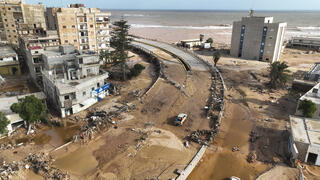
The pride of the Libyan port city of Derna once lay in its ancient mosque with 42 minarets and its long history. Now, nearly a year and a half after the deadliest flood of the 21st century devastated the city , the failures that led to the disaster — which claimed the lives of more than 10,000 people — are becoming clearer. The emerging picture shows the disaster was not merely the result of a natural catastrophe but also of long-standing planning failures.
The findings carry global significance, including for Israel. The flood in Derna ( Video: Dr. Yuval Shmilovitz, Dr.

Moshe Armon, Dr. Elad Dente ) A new study involving Dr. Moshe Armon of the Institute of Earth Sciences at the Hebrew University of Jerusalem, Dr.
Yuval Shmilovitz of the Cooperative Institute for Research in Environmental Sciences at the University of Colorado, and Dr. Elad Dente of the School of Environmental Sciences at the University of Haifa reveals that the deadly flood in Derna in September 2023 was not an unavoidable act of nature but rather the result of serious miscalculations in infrastructure planning. The study, published in the journal Science Advances, shows that flood protection systems built in the Derna basin were designed based on a severe underestimation of the expected intensity of floods in the area.
4 View gallery The city of Derna ( Photo: Jamal Alkomaty, AP ) The research team analyzed rainfall and flood data in Derna and concluded that storms similar in strength to Storm Daniel, which struck Libya in September 2023 and led to thousands of deaths and massive destruction in the city, were not as rare as the original dam designers assumed. Using an innovative combination of hydrological and meteorological models alongside satellite data analysis, the researchers determined that a flood of similar magnitude could be expected every few decades — not once every 10,000 years, as engineers believed when they planned the city’s dams. Despite clear warning signs of flawed planning, there was no adequate preparation for the possibility of dam failure.
The study found that the collapse of the dams amplified the flood’s destructive power by 20 times compared to a scenario without the dams in place. The extensive devastation, which included the destruction of more than 1,000 buildings in Derna, highlights the dangerous illusion of security that can result from relying on protective infrastructure designed without accounting for the variability of natural forces. 4 View gallery ( Photo: Jamal Alkomaty, AP ) The findings carry critical implications for flood defense planning in Mediterranean and arid regions, including Israel.
However, it’s important to note that year-to-year climate variability is increasing — largely due to human-driven factors and greenhouse gas emissions — making it harder to predict extreme, once-rare events that now carry a growing risk to lives and property. 4 View gallery Hydraulic simulation results of the Derna flood following the collapse of the dams (right) and in a scenario without dams upstream of the city (left). Darker purple indicates higher flood intensity.
It is evident that the collapse of the dams caused a powerful flood that struck large areas of the city, leading to extensive building destruction (red dots). Without the dams, the "Daniel" storm flood would have also inundated parts of the city but in a more limited fashion. Additionally, the higher flood intensities were confined to the channel crossing the city ( Photo: Dr.
Yuval Shmilovitz, Dr. Moshe Armon, Dr. Elad Dente ) “The dams in Derna were not originally built to withstand what happened in September 2023,” explained Dr.
Armon. “Proper dam and drainage system planning must account for uncertainty and potential failure scenarios. Today, we have advanced tools that can help in responsible planning.
” 4 View gallery ( Photo: Muhammad J. Elalwany, AP ) He added: “We must learn from the Derna disaster and reassess our own preparedness for similar events, especially in light of climate change. In Derna, authorities instructed residents to stay in their homes as the storm approached.
But residents had no training to deal with such an event and received no guidance that could have saved their lives, such as moving to higher ground.” Get the Ynetnews app on your smartphone: Google Play : https://bit.ly/4eJ37pE | Apple App Store : https://bit.
ly/3ZL7iNv The Derna flood disaster serves as a major warning sign for planners and communities living downstream from dams. The study raises key questions about risk management and flood preparedness — including in Israel, where urban flooding has become a recurring issue in recent years. The researchers emphasize the need to adapt defense and warning infrastructure, as well as urban development planning along waterways, to the climatic realities of each region, while transparently communicating potential failure scenarios to the public.
>.















